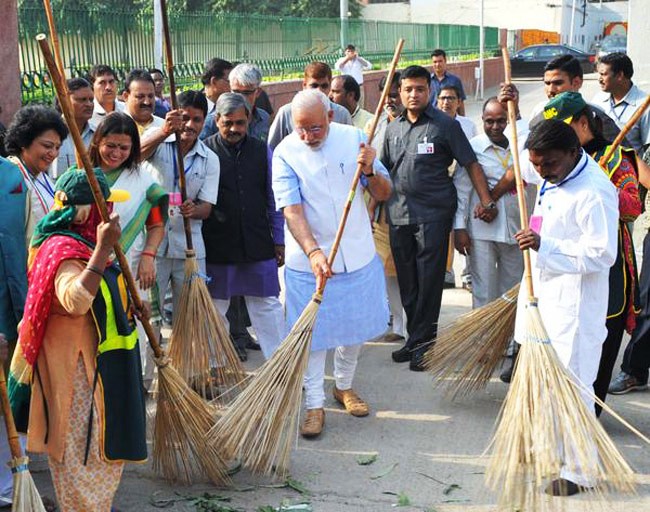by Sandeep Pandey
Are we any cleaner than before Narendra Modi and all the people who wanted to be photographed with the broom took to sweeping? What happened to the garbage which they cleaned? Where was it disposed? Most of the photographs of people with the broom did not show any garbage. This implies they were cleaning at an already clean place. None was, for example, shown cleaning a toilet. The whole campaign was initiated on Mahatma Gandhi’s birthday and the insignia used with the campaign clearly marks it being inspired by Gandhian philosophy. But Gandhi made people clean toilets whenever somebody went as a volunteer to him. If the people who came out to sweep clean roads were really serious about cleaning they should have gone inside public toilets, especially the unclean ones and should have cleaned them. How many people who participated in Narendra Modi driven cleanliness campaign actually cleaned any garbage or waste? Was it a one time show or people will do it regularly? Do they ever clean their own homes? Or they depend on the women of the family or domestic helps to do this?
No credit has been given to the community of sweepers, mostly belonging to scheduled castes, who perform the cleaning for us every day. We forgot to thank them. In fact, the task of cleaning is so stigmatized, that most people other than the castes which traditionally perform this task would not do it under normal circumstances. Persons from other castes who get employed as sweepers sub-contract their job to somebody belonging to castes which traditionally do this work by offering a small share of their salary. This job is considered a thankless job. The second question which needs to be asked is whether there has been any qualitative change in the lives of people traditionally engaged in cleaning work for the whole society? Have we found an alternative to a human being directly entering a sewage drain? It is not uncommon to hear of workers dying because of suffocation due to toxic gases like hydrogen sulphide when they enter sewage drains. Which civilized society would allow its citizen to perform an inhuman task like entering sewage drains? But the practice continues without any remorse on part of the civilized society. Modern technology makes the lives of people comfortable and has come up with many devices to reduce drudgery. But it is not considered necessary to employ technology to clean the sewage drains without human beings entering it.
The worst among the community who does the cleaning jobs are manual scavengers, and among them mostly their women. In 1993 Employment of Manual Scavengers and Construction of Dry Laterines (Prohibition) Act was implemented which made employment of manual scavengers or construction of dry or non-flush latrines illegal. How serious is the government about implementing this Act is clear from the fact that nobody has been found guilty under this law during the last two decades.
Now the government has come up with Prohibition of Employment as Manual Scavengers and their Rehabilitation Act in 2013 which clearly implies that the practice still exists. Most DMs would deny that the practice exists in their districts or most CMs would deny that it exists in their states. But the reality is quite different. According to a 2001 census about 2 crore people are engaged in this employment in 29 states, extending from Tamil Nadu to Jammu and Kashmir and from Gujarat to Mizoram, which implies it is truly an all India menace.
Manual scavenging will go away only when people have improved sanitation. According to 2010 data only 34% of Indian population has access to improved sanitation. Comparing with our neighbours, in Sri Lanka, China, Bangladesh, Pakistan and Bhutan, respectively, 92%, 64%, 56%, 48% and 44% of population has access to improved sanitation. Only Nepal fares poorer than India with 31% population having improved sanitation. During the two decades from 1990 to 2010, while China went up from 24% of its population having access to improved sanitation to 64%, India rose merely from 18% to 34% during this period. The percentage increase in China was almost double that of India.
Finally, the crucial question is how is the garbage being disposed? In most cities it is sent to landfills, which are actually agricultural fields. In Lucknow the landfill is next to Gomti river in Dubagga. It is polluting our land and water. In Varanasi the garbage is being deposited next to Varuna river which joins Ganga and sewage flows directly into Ganga, half of it untreated.
Narendra Modi’s campaign will do more harm than good because people will feel a sense of complacency after picking up the broom without realizing that their act has not had an iota of difference on the actual state of affairs of cleanliness. This appears to be part of Narendra Modi’s style of politics where he makes people feel better without changing the ground reality. This style may be good for his politics and will help keep him in power but is it going to solve any real problems of people?
The cleanliness drive is simply sweeping the garbage under the carpet. The carpet is the illusion created by Narendra Modi that something is happening. We need concrete solutions in terms of safe garbage disposal, waste treatment, recycling projects and improved sanitation, about which there seems to be little discussion. Such a superficial campaign will fritter away in no time leaving people disillusioned.






















